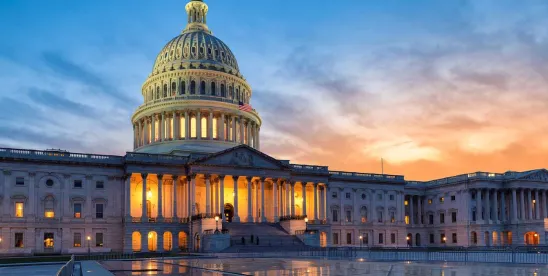As lawmakers return to Washington this September, they face a critical — and fast-approaching — deadline. By October 1, Congress must decide how to fund the federal government for fiscal year 2026. Failure to do so could result in a partial government shutdown.
It’s natural to wonder whether the FY 2026 appropriation bills will pass in time to keep federal operations running.
To begin, there are 12 appropriation bills, each responsible for funding one or more federal agencies. In the regular order of business, each must move through committee markups and floor votes in both the House and Senate, then the competing versions must be agreed upon by both chambers before receiving the President’s signature.
Progress this year has been slow.
So far, the Senate has passed only three bills — Agriculture; Military Construction, Veterans Affairs, and Related Agencies; and the Legislative Branch — while the House has approved just two: Defense and Military Construction, Veterans Affairs, and Related Agencies. With time running short, lawmakers are weighing their options, which include a full- or partial-year Continuing Resolution (CR), a “minibus” spending package that includes a handful of spending bills, a shutdown, or a combination of these approaches.
Let’s break this down.
With little chance of passing all the FY 2026 appropriation bills before the October 1 start of the fiscal year, federal agencies are preparing for a CR. A CR is a common stopgap measure that allows agencies to operate at the prior year’s funding levels for a set period — ranging from a few days to a full year. Typically, it is used as a stopgap measure to give lawmakers more time to finalize annual spending bills.
Both the House and Senate must agree on the CR’s contents, including its duration. Options include:
- A short-term CR, lasting several weeks or months.
- A full-year CR, which is how the federal government is currently funded. Under this scenario, FY 2026 funding would remain at FY 2025 levels. Drawbacks include stagnant funding, delays in launching new programs, hiring freezes, postponed contract awards, and the possible exclusion of funding for Community Project Funding (House) or Congressionally Directed Spending (Senate), which fund district- and state-specific projects.
Another possibility is a hybrid approach, in which some federal agencies operate under a CR while others receive full FY 2026 funding. This can be achieved through the enactment of a “minibus” package, where multiple appropriation bills are bundled together for passage. Under this approach, certain agencies would continue at prior-year funding levels, while others would operate under newly approved budgets.
There is a scenario in which both chambers cannot agree on a CR or passage of the 12 funding bills causing a lapse in appropriations, more commonly known as a government shut down.
In a shutdown, some federal employees are furloughed while those performing an excepted function must continue working. These excepted functions are for the protection of life, property and public safety, which is why our troops stay on duty, they just won’t receive a paycheck until the appropriations have been enacted. Shutdowns typically cause service delays, closures of national facilities, and disruptions to programs that Americans rely on. Further, these disruptions do not result in any savings to the taxpayer, as the employees are entitled to their backpay, even if they were furloughed.
Adding another layer of complexity, a hybrid scenario could emerge in which some federal agencies operate under shutdown procedures while others function under a CR or a fully passed annual appropriation. Under this scenario, the agencies and the Administration coordinate on specific operational guidance for each federal agency in a shut down. The guidance identifies which government functions may not continue until there is a CR or appropriation. It is possible, that under a shutdown some, departments within an agency may remain operational whereas others are not.
The central challenge remains securing agreement between the House, Senate, and the Administration on how to fund the government. When appropriations earmarks were reinstated in both chambers, some lawmakers may have assumed they would help secure enough votes to pass the legislation. However, as demonstrated during the FY 2025 process, funding special projects in a member’s district or state was not enough to overcome broader disagreements and push the bills across the finish line.
So, where does that leave us?
The path to funding the federal government remains uncertain. With roughly two weeks left to complete the 12 spending bills, the most likely outcome is a CR for a set period, followed — hopefully — by progress toward passing all 12 bills. Appropriators are eager to finish their work and ensure essential services remain available to the American people.
Stay tuned as we continue to track the federal funding process.
| Federal Funding Outcome | Explanation |
| Passage of all 12 Funding Bills | All agencies operate under FY 2026 funding levels |
| Government-wide year-long CR | The federal Government operates under the previous fiscal year’s spending level. (Some exceptions may apply.) |
| Short Term CR | The federal Government operates under the previous fiscal year’s spending level for a specific period – less than a year. |
| Partial CR and “minibus” | Some bills are grouped together in a “minibus” for passage. In this scenario some federal agencies have access to FY 2026 funding, while the remaining agencies operate under the previous year’s funding levels. |
| Government-wide Shut down | The government shuts down – However, some federal services and functions will remain operational. (See explanation above) |
| Partial Shutdown with a CR | Some federal agencies are shutdown while others are under a CR. |
| Partial Shutdown with a minibus | Some federal agencies are shutdown while others operate under FY 26 funding levels. |




 />i
/>i
